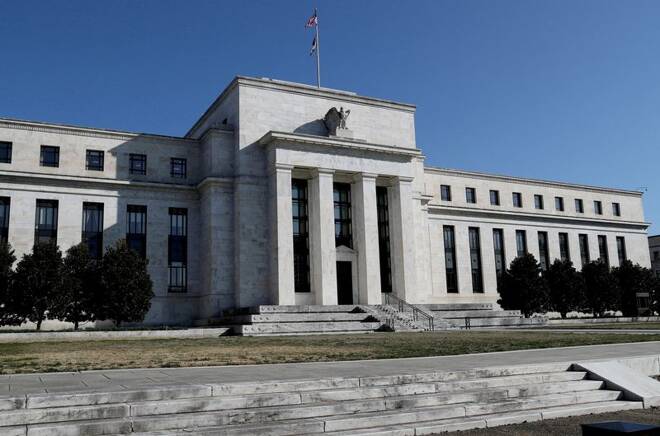Advertisement
Advertisement
Marketmind: Fed halt being priced as bank blaze smoulders
By:
A look at the day ahead in U.S. and global markets from Mike Dolan
A look at the day ahead in U.S. and global markets from Mike Dolan
Another weekend of financial firefighting has doused the whole interest rate horizon as the banking blaze smoulders.
Central banks face a battle to separate serial financial rescues from underlying monetary policy. But world markets now bet their interest rate rise campaigns are over amid fears that an unfolding credit crunch resulting from increasingly stressed banks just hastens recession and disinflation on its own.
Futures markets now only see a one-in-three chance that the Fed will go ahead with a final rate hike this Wednesday and they see up to a percentage point of rate cuts by yearend.
As U.S. authorities struggle with workouts of two failed regional banks and resulting depositor runs that have undermined others, European markets are trying to assess the implications of a forced marriage in Swiss banking on Sunday.
In emergency weekend meetings, Swiss authorities orchestrated a deal for UBS to buy ailing rival bank Credit Suisse for $3.2 billion – at a fraction of Friday’s battered CS share price – to prevent a failure of the systemically important Credit Suisse sending shockwaves through world banking.
The details of the buyout did little to ease market tensions first thing on Monday, with the UBS share price falling 12% in early trade and euro zone bank stock indices down another 3%.
Of particular concern was the impact on wider bank funding markets of a controversial decision to wipe out Credit Suisse’s junior bondholders even as equity investors gained something from the UBS deal. European bank chiefs were immediately on guard for further contagion and insisted more support was required.
Acknowledging the risk of wider stress shortly after the Swiss deal, the U.S. Federal Reserve, European Central Bank and other major central banks issued statements to reassure markets and announced coordinated action to provide U.S. dollar liquidity where needed and backstop their banking systems.
But in displaying that level of concern, the authorities merely underlined the potential of the shock and its implications for lending, growth and inflation.
“There’s going to be less credit. Less credit means less growth. So, some of the mission of the Fed in trying to slow the economy will be done here,” former Goldman Sachs chief executive Lloyd Blankfein said on Sunday.
And that thinking has crushed the interest rate horizon everywhere.
Futures markets now see the first Fed rate cut emerging by midyear. No further ECB rate rises are fully priced after it pushed ahead with a hefty half-point rate rise in the thick of the crisis last week and there’s less than a 50% chance of a further Bank of England rate rise when it meets this week.
U.S. Treasury yields plunged across the curve, with 2-year yields hitting 6-month lows of 3.6% and 10-year yields also hitting 6-month lows at 3.29%.
The steepening of the 2-10-year curve to show an inversion of just 40 bps was cold comfort as investors pointed out that the long-inverted curve – frequently a harbinger of recession and stress – often steepens just before the actual recession hits.
U.S. stock futures were down about 0.5% ahead of the open but the VIX volatility gauge jumped three points to near 29.
A U.S. official said on Sunday that the deposit outflows that left many regional banks reeling in the wake of Silicon Valley Bank’s failure had slowed and in some cases reversed – but European banking worries and credit rating downgrades for some of the banks kept markets on edge.
The U.S. Federal Deposit Insurance Corp is planning to relaunch the sale of Silicon Valley Bank after failing to attract buyers in its latest auction, possibly seeking a potential break-up of the collapsed lender. One of the options under consideration by the regulator is a sale of SVB’s private banking arm, which caters for wealthy clients.
Even though Fed discount window lending and liquidity provision was seen by some as a resumption of some form of quantitative easing, banks such as Morgan Stanley cautioned against reading it that way – stressing that Fed asset purchases were hugely different to emergency loans.
“It won’t stop the already tight lending standards across the banking industry from getting even tighter. It also won’t prevent the cost of deposits from rising, thereby pressuring net interest margins,” Morgan Stanley said on Sunday. “In short, the risk of a credit crunch has increased materially.”
Key developments that may provide direction to U.S. markets later on Monday:
* Meetings and statements on banking worries.
* European Central Bank President Christine Lagarde speaks at the European Parliament in Brussels
* Chinese President Xi Jinping meets Russian President Vladimir Putin in Moscow.



(By Mike Dolan, editing by Nick Macfie mike.dolan@thomsonreuters.com. Twitter: @reutersMikeD)
About the Author
Reuterscontributor
Reuters, the news and media division of Thomson Reuters, is the world’s largest international multimedia news provider reaching more than one billion people every day. Reuters provides trusted business, financial, national, and international news to professionals via Thomson Reuters desktops, the world's media organizations, and directly to consumers at Reuters.com and via Reuters TV. Learn more about Thomson Reuters products:
Did you find this article useful?
Latest news and analysis
Advertisement
